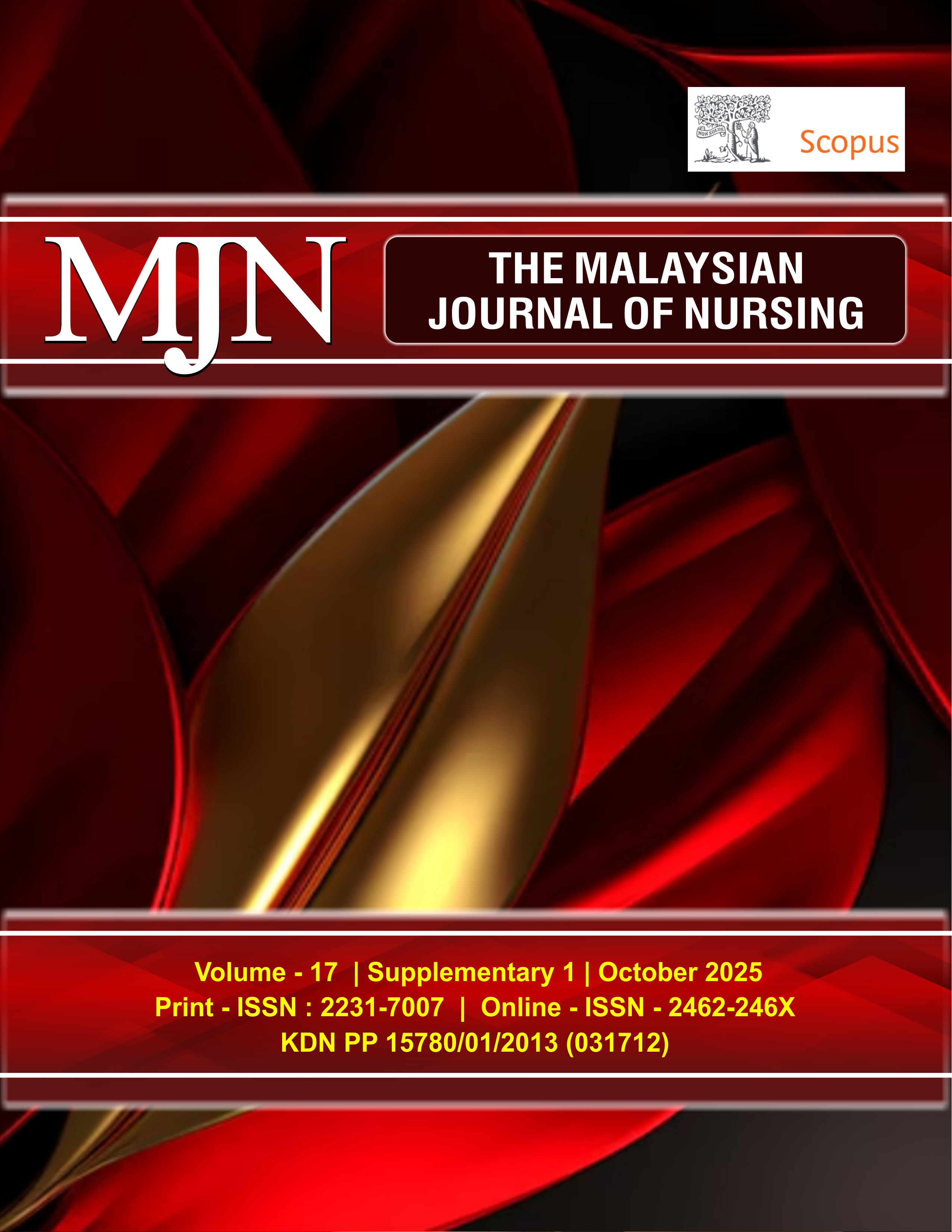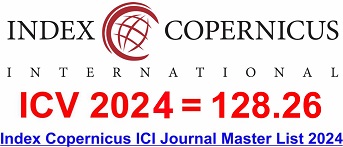Optimizing Oxygen Saturation and Pulse Rate in Premature Infants: The Role of Nesting and Prone Positioning
DOI:
https://doi.org/10.31674/mjn.2025.v17isupp1.012Abstract
Background: Low birth weight babies often experience complications in the form of respiratory distress syndrome and increased heart rate. A method to help prevent these complications is positioning the infant in a nesting and prone arrangement. Objective: This study aimed to examine the effect of nesting and prone positions on oxygen saturation and heart rate in premature infants. Methods: Pre-experimental design included 44 premature infants selected through consecutive sampling from the neonatal care unit at Arifin Achmad Hospital Pekanbaru. Data analysis was performed using univariate and bivariate techniques, with the Wilcoxon test applied for the bivariate analysis. Results: The mean oxygen saturation of respondents before intervention was 92.95%, which increased to 97.34% post-intervention. The mean heart rate before intervention was 129.66 and 150.86 after intervention. Statistical testing indicated a significant difference in oxygen saturation before and after using the nesting and prone positions (p < 0.05). Conclusion: Implementing nesting and the prone position can improve oxygen saturation in premature babies, as it lowers body metabolism, reduces heat loss, and enhances respiratory efficiency.
Keywords:
Nesting, Nursing, Premature, Prone PositionDownloads
References
Akter, S., Perveen, J., Ferdousi, F., Yasmin, F., Hossain, M. A., Afreen, S., & Dey, S. K. (2024). Impact of Kangaroo mother care plus massage therapy on growth of preterm low birth weight infants at discharge. International Journal of Contemporary Pediatrics, 11(12), 1703–1710. https://doi.org/10.18203/2349-3291.ijcp20243465
Alinejad-Naeini, M., Peyrovi, H., & Shoghi, M. (2021). Self-reinforcement: coping strategies of Iranian mothers with preterm neonate during maternal role attainment in NICU; a qualitative study. Midwifery, 101, 103052. https://doi.org/10.1016/j.midw.2021.103052
Chaturvedi, S., Randive, B., Pathak, A., Agarkhedkar, S., Tillu, G., & Darmstadt, G. L. (2020). Prevalence and perceptions of infant massage in India : study from Maharashtra and Madhya Pradesh states. BMC Pediatrics, 20, 512. https://doi.org/10.1186/s12887-020-02416-y
Elsagh, A., Lotfi, R., Amiri, S., & Gooya, H. H. (2019). Comparison of massage and prone position on heart rate and blood oxygen saturation level in preterm neonates hospitalized in Neonatal Intensive Care Unit a randomized controlled trial. Iranian Journal of Nursing and Midwifery Research, 24(5), 343–347. https://doi.org/10.4103/ijnmr.IJNMR_34_18
El-sayd, H. M., El-Mashad, G. M., Mohamed, M. Z. E., & Abouzouna, Z. S. (2023). Comparison of massage and prone position on heart rate and blood oxygen saturation level in preterm neonates hospitalized in neonatal intensive care units. Egyptian Pediatric Association Gazette, 71(1). https://doi.org/10.1186/s43054-023-00214-6
Ghorbani, F., Asadollahi, M., & Valizadeh, S. (2013). Comparison the effect of sleep positioning on cardiorespiratory rate in noninvasive ventilated premature infants. Nursing and Midwifery Studies, 1(4), 182–187. https://doi.org/10.5812/nms.10318
Gözen, D., Erkut, Z., Uslubaş, R., & Bilgin, L. (2022). Effect of different positions on gastric residuals in preterm infants initiating full enteral feeding. Nutrition in Clinical Practice, 37(4), 945–954. https://doi.org/10.1002/ncp.10789
Indartik, I., Khasanah, N. N., & Wahyuni, S. (2025). Nesting technique as a simple method for optimal outcomes in premature infant care: a literature review. Indonesian Journal of Global Health Research, 7(2), 583–594. https://doi.org/10.37287/ijghr.v7i2.5650
Indartik, I. (2019). The performance of nurses to improve the responsibility quality of nursing services. Indonesian Journal of Global Health Research, 2(4), 583–594. https://doi.org/10.37287/ijghr.v2i4.250
Jani, P. R., Lowe, K., Perdomo, A., Waters, K. A., Badawi, N., & Tracy, M. (2021). Cerebral oxygenation and perfusion when positioning preterm infants: clinical implications. The Journal of Pediatrics, 235, 75–82. https://doi.org/10.1016/j.jpeds.2021.04.008
Kahraman, A., Başbakkal, Z., Yalaz, M., & Sözmen, E. Y. (2018). The effect of nesting positions on pain, stress and comfort during heel lance in premature infants. Pediatrics and Neonatology, 59(4), 352–359. https://doi.org/10.1016/j.pedneo.2017.11.010
Karabulut, M., & Uslu, H. S. (2024). Effect of sleeping position on cardiac output, pulmonary pressure, and superior vena cava flow in healthy term infants. Pediatrics and Neonatology, 65(3), 229–236. https://doi.org/10.1016/j.pedneo.2023.09.003
Kuehne, B. T. (2022). Differences in caregiver attitudes towards neonatal oxygen titration (Doctoral dissertation. Franklin University, Health Programs). OhioLINK. Retrieved from: http://rave.ohiolink.edu/etdc/view?acc_num=frank1654001976074863. Accessed on 24th January 2024.
Lee, H., Park, J. H., & Cho, H. (2022). Analysis of research on developmentally supportive care for prematurity in neonatal intensive care unit: a scoping review. Child Health Nursing Research, 28(1), 9–22. https://doi.org/10.4094/chnr.2022.28.1.9
LoBiondo-Wood, G., Haber, J., & Berry, C. (2022). Nursing research: methods and critical appraisal for evidence-based practice (10th ed.; G. LoBiondo-Wood, Ed.). Elsevier Inc. Retrieved from: https://doi.org/https://www.google.co.id/books/edition/Study_Guide_for_Nursing_Research_E_Book/YWM4EAAAQBAJ?hl=jv&gbpv=1 . Accessed on 16th February 2024.
Loi, B., Regiroli, G., Foligno, S., Centorrino, R., Yousef, N., Vedovelli, L., & De Luca, D. (2023). Respiratory and haemodynamic effects of 6h-pronation in neonates recovering from respiratory distress syndrome, or affected by acute respiratory distress syndrome or evolving bronchopulmonary dysplasia: A prospective, physiological, crossover, controlled cohort study. EClinicalMedicine, 55, 101791. https://doi.org/10.1016/j.eclinm.2022.101791
Ma, M., Noori, S., Maarek, J. M., Holschneider, D. P., Rubinstein, E. H., & Seri, I. (2015). Prone positioning decreases cardiac output and increases systemic vascular resistance in neonates. Journal of Perinatology, 35(6), 424–427. https://doi.org/10.1038/jp.2014.230
Miller-Barmak, A., Riskin, A., Hochwald, O., Haddad, J., Dinur, G., Vortman, R., Kugelman, A., & Borenstein-Levin, L. (2020). Oxygenation instability assessed by oxygen saturation histograms during supine vs prone position in very low birthweight infants receiving noninvasive respiratory support. The Journal of Pediatrics, 226, 123–128. https://doi.org/10.1016/j.jpeds.2020.06.066
Noor, M., Hasanah, O., & Glinting, R. (2016). Penggunaan nesting dengan fiksasi mampu menjaga stabilitas saturasi oksigen, frekuensi pernafasan, nadi [The use of nesting with fixation is able to maintain the stability of oxygen saturation, respiratory rate, and pulse]. Jurnal Ners Indonesia, 6(1), 65–76. https://doi.org/10.31258/JNI.6.1.64-75
Oishi, Y., Ohta, H., Hirose, T., Nakaya, S., Tsuchiya, K., Nakagawa, M., Kusakawa, I., Sato, T., Obonai, T., Nishida, H., & Yoda, H. (2018). Combined effects of body position and sleep status on the cardiorespiratory stability of near-term infants. Scientific Reports, 8(1), 1–8. https://doi.org/10.1038/s41598-018-27212-8
Park, S., Jeong, S. J., Han, J. H., Shin, J. E., Lee, J. H., & Kang, C. M. (2024). Natal factors affecting developmental defects of enamel in preterm infants: A prospective cohort study. Scientific Reports, 1–10. https://doi.org/10.1038/s41598-024-52525-2
Prescott, M. G., Geist, M., Olsson, E., Fiander, M., Soll, R. F., & Bruschettini, M. (2024). Infant positioning for promoting development and preventing morbidity in preterm infants (Protocol). Cochrane Database of Systematic Reviews, 2024(12), CD016029. https://doi.org/10.1002/14651858.CD016029
Rad, Z. A., Mojaveri, M. H., Hajiahmadi, M., Ghanbarpour, A., & Mirshahi, S. (2021). The effect of position on oxygen saturation and heart rate in very low birth weight neonates. Caspian Journal of Pediatrics, 2(2), 153–157. https://doi.org/10.22088/acadpub.BUMS.2.2.153
Rahayu, I. L., Indarwati, F., & Anisah, L. (2025). Pengaruh pemberian posisi pronasi terhadap peningkatan saturasi oksigen pada neonatus dengan distress respirasi di NICU RSUD temanggung [The effect of prone position on increasing oxygen saturation in neonates with respiratory distress in the NICU of Temanggung Regional Hospital]. Universitas Muhammadiyah Yogyakarta, 8(2), 47–53. https://doi.org/10.54107/medikausada.v8i1.389
Rahmawati, A., Herawati, H. E., Zahrah, M., & Septimar, M. (2024). Counseling on The Use of Nesting for Low Birth Weight (LBW) Babies in The Perinatology Room of Banten Province Hospital. ABDIMAS Jurnal Pengabdian Masyarakat, 7(4), 1676–1682. https://doi.org/https://doi.org/10.35568/abdimas.v7i4.5389
Saprudin, N., & Sari, I. K. (2018). Pengaruh penggunaan nesting terhadap perubahan suhu tubuh saturasi oksigen dan frekuensi nadi pada bayi berat badan lahir rendah di Kota Cirebon [The effect of nesting use on changes in body temperature, oxygen saturation, and pulse rate in low birth weight babies in Cirebon city]. Jurnal Ilmu Kesehatan Bhakti Husada: Health Sciences Journal, 9(2), 16–26. https://doi.org/10.34305/jikbh.v9i2.63
Saputro, M. G., Rifai, A., Sumardino, S., & Sugiyarto, S. (2023). The effect of prone position on oxygen saturation in premature infants. Jurnal MID-Z (Midwivery Zigot) Jurnal Ilmiah Kebidanan, 6(1), 77–87. https://doi.org/10.56013/jurnalmidz.v6i1.2155
Schmölzer, G. M., Asztalos, E. V., Beltempo, M., Boix, H., Dempsey, E., El-Naggar, W., Finer, N. N., Hudson, J. A., Mukerji, A., Law, B. H. Y., Yaskina, M., Shah, P. S., Sheta, A., Soraisham, A., Tarnow-Mordi, W., & Vento, M. (2024). Does the use of higher versus lower oxygen concentration improve neurodevelopmental outcomes at 18–24 months in very low birthweight infants? Trials, 25(1), 1–13. https://doi.org/10.1186/s13063-024-08080-2
Sekhavat, L., & Tezerjani, F. Z. (2013). The role of foetal sex on preterm labour. International Journal of Fertility & Sterility, 7(Suppl 1), 117–118.https://www.ijfs.ir/article_45877_cac04383902e5f5ec024863bed8e35f1.pdf
Skelton, H., Psaila, K., Schmied, V., & Foster, J. (2023). Systematic review of the effects of positioning on nonautonomic outcomes in preterm infants. Journal of Obstetric, Gynecologic & Neonatal Nursing, 52(1), 9–20. https://doi.org/10.1016/j.jogn.2022.09.007
Sun, K. P., Zhou, S. J., Chen, X. H., Zheng, Y. R., & Chen, Q. (2024). Effect of prone positioning ventilation on pulmonary function in neonates during venous-arterial extracorporeal membrane oxygenation. Translational Pediatrics, 13(4), 575–583. https://doi.org/10.21037/tp-23-485
Tufail, A., Chaudhary, I. T., Ahmad, I., Arshad, I., Akram, M., & Butt, M. A. (2023). Effect of prone position on oxygen saturation in neonates having respiratory distress. Pakistan Armed Forces Medical Journal, 73(Suppl-1), S282–S285. https://doi.org/10.51253/pafmj.v73iSUPPL-1.11028
Wyckoff, M. H., Wyllie, J., Aziz, K., de Almeida, M. F., Fabres, J., Fawke, J., Guinsburg, R., Hosono, S., Isayama, T., Kapadia, V. S., Kim, H. S., Liley, H. G., McKinlay, C. J. D., Mildenhall, L., Perlman, J. M., Rabi, Y., Roehr, C. C., Schmölzer, G. M., Szyld, E., … & Weiner, G. M. (2020). Neonatal life support: 2020 international consensus on cardiopulmonary resuscitation and emergency cardiovascular care science with treatment recommendations. Circulation, 142(16_Suppl_1), S185–S226. https://doi.org/10.1161/CIR.0000000000000895
Published
How to Cite
Issue
Section
License
Copyright (c) 2025 The Malaysian Journal of Nursing (MJN)

This work is licensed under a Creative Commons Attribution-NonCommercial-NoDerivatives 4.0 International License.



































